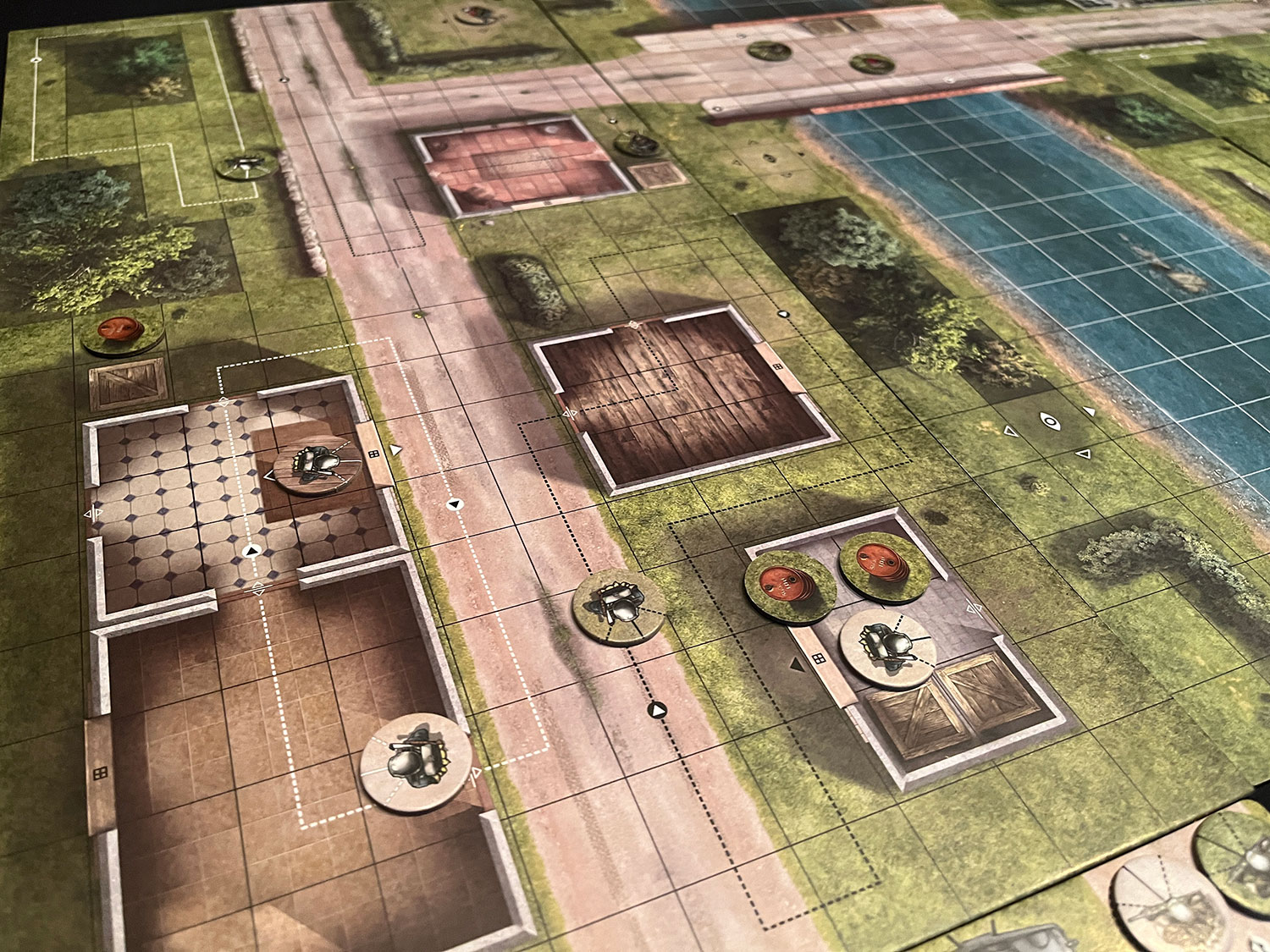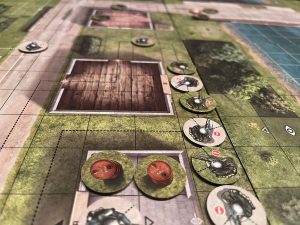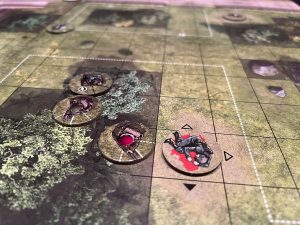 Stealth action games are one of my favorite genres in video games. If there is an option to create a tough soldier who charges into battle and goes hog wild, or a sneaky person who prowls around taking out enemies from the shadows, I’m always going to choose the latter. So when a new stealth/infiltration board game pops up, you know I’ve got to give it a try.
Stealth action games are one of my favorite genres in video games. If there is an option to create a tough soldier who charges into battle and goes hog wild, or a sneaky person who prowls around taking out enemies from the shadows, I’m always going to choose the latter. So when a new stealth/infiltration board game pops up, you know I’ve got to give it a try.
A newcomer to the genre is SAS Rogue Regiment, a cooperative/solo infiltration game published by Word Forge Games. So grab your kit and get ready to jump out of the plane as we see what makes this one tick.
Gameplay Overview:
SAS Rogue Regiment is one of those games with a simple, logical game flow, with about a bazillion exceptions. Ok, it’s not that bad, but there are a lot of little rules to be aware of. So with that in mind, here is a high-level overview of the gameplay. If you want the full ins and outs, you can download a PDF of the rulebook here.

The game will play slightly differently depending on if you are in the Stealth Section or the Battle Section. But you start the game with a number of Operators and a mission to complete. Each round begins with the Operator Phase. Each of your units gets 4 action points to do things like move around the board, attack enemies, pick up things (items and corpses), or hide.
Attacks can either be a silent assassination (knife to the back), or a shot with your gun. Taking a shot requires rolling a six-sided die and applying any modifiers for aiming or Short Range. One hit will take out any troop, while vehicles need more damage (or explosives).
After the Operator phase, any alert axis units will advance on spotted operators. Then an event card is drawn, which will throw a monkey wrench into your plans by rotating sentries, changing the facing on patrol routes, or even just advancing the alarm tracker. After the event, each Axis patrol unit will move 4 spaces forward, and any alert units will shoot at spotted operators.
At the end of the round, the alarm tracker advances one spot for each alert Axis unit. If, at any time, the tracker gets to zero, players switch to the Battle Section. This section works a lot like the Stealth section with a few notable changes. All Axis units are on alert, and instead of patrolling, they will move towards the nearest spotted operator. The event card will also feature a lot more reinforcements, so you’ll have to battle waves of enemies. The time for stealth is over.
If the operators can achieve their objective and make it back to their extraction point, they win.

Game Experience:
SAS Rogue Regiment has a really rewarding stealth section. It encourages you to carefully plan your actions and approach with caution. Even from the start of the game, you need to think about your mission, your route, and how you are going to accomplish your objective and get home. I thought it was a nice touch that each patrol route has two starting spots, so you can even choose where the Axis units begin.
It is also one of the more forgiving games in that being spotted doesn’t immediately end your stealth run. You can make a move, be spotted, take out that same unit, and, as long as you are quiet, you have no loss of stealth. However, if you happen to get spotted and don’t immediately deal with the threat, the alert unit will yell to any other unit within 4 spaces, so things can get out of hand if you make a bad move. That’s why, in the stealth section, the handy knife will be your best friend. Sneak up behind an enemy through the trees, take him out quietly, and then dump his body in the forest. It takes careful planning, but it’s also the best way to make sure Hans doesn’t call for help.

However, as the old adage goes, “No plan survives first contact with the enemy”. As much as a puzzle as SAS Rogue Regiment can be, the game likes to keep you on your toes. Stealth kills are automatic, so you don’t have to worry about the dice screwing you over here. Yet the event cards will do that just fine on their own. You might have the perfect route and assassination planned, only for the event card to cause a sentry to sweep in a different direction, leaving your planned route in his line of sight. More than once I’ve had a unit patrolling flip direction, only to spot me carrying the dead body of his friend. Oops. While moments like that are frustrating to your carefully laid out plan, they do create tension and unique stories for the game.
As I mentioned above, the game can be a little forgiving for a few mistakes here or there, but for the most part, you will eventually hit the battle section. The goal is to make that as late as possible. Because, like most stealth action games, you can easily get overwhelmed in the battle section. Units are spawning, they have the numbers, and they are coming for you. I don’t think any board game has quite figured out how to deal with the post-stealth section other than throwing tons of units at you, which isn’t always very much fun. At least with SAS Rogue Regiment, you can kind of see it coming, vs an unlucky die roll in other games.

One area where I think SAS Rogue Regiment could use a boost is with its Operator variety. The game comes with 4 operators, each with 2 load-outs. However, after 5-6 missions, where you use most of them, I started wishing for a few more options. It would have been nice to be able to customize their load-outs more than just Side 1 or 2. What I really wish for though was more silenced attacks. Right now, you either need to move directly behind the unit and use your knife, or bring along Anders with his harpoon gun. It gives you a 2 range shot. But outside of that, you will not be using guns very much until the Battle Phase (each shot during the Stealth section moves the alarm token).
Speaking of options, the publisher did include a copy of the 3 expansions with the review copy of the core game. While they aren’t big enough to warrant a full review on their own, I do want to touch on what they add. Two of them are pretty straightforward, the Heavy Metal and Hot Dog expansions. The first adds 3 new vehicles to the Axis forces, while Hot Dogs adds flame troopers and dogs. These work nicely to give you a bit more variety to your game and each even includes a new mission. The 3rd, the Jager expansion, changes things up the most as it adds in Jager mode, which turns the game into a 1 vs Many game instead of fully coop. Whether you need that expansion depends on if your group likes 1 vs Many. If not, you should just get the Heavy Metal and Hot Dog for the added variety.

Finally, I want to touch on the learning curve briefly. I mentioned above that SAS Rogue Regiment has a lot of little rules, and it does. Expect to play a learning game or two to really wrap your head around the system. The movement system has different rules for going over different types of terrain, and line of sight has a whole diagram to show when you can and can’t be seen depending on which cover you are in/behind and if you are crouching or not. It’s a lot to take in. The rules are all there, and plenty of examples are provided, but there is just a lot to remember. Sometimes during our game, we’d just make a ruling for what seemed most reasonable rather than digging into the rulebook again.
Final Thoughts:
Overall, I think SAS Rogue Regiment is one of the best of the genre and a really great system. It will probably be compared to Assassin’s Creed: Brotherhood of Venice or V-Commandos, but I think it’s superior to both when it comes to stealth rules. I like having a lot more control here, yet still needing to take precautions due to the event cards.
What it could use is just more variety in the operators, both personal and load-outs. That and figuring out a way to not turn the battle phase into swarms of enemies descending on you over and over. But other than that the game is pretty great and works well both as a solo endeavor and for cooperative play. And for those who like 1 vs Many, the option Jager expansion adds that in as well.
Final Score: 4 Stars – A great stealth action game that rewards careful planning and strategic thinking.
 Hits:
Hits:
• Some of the best stealth mechanics in the genre
• Nice mission variety
• Event cards work well to keep the tension high
Misses:
• Needs more variety for the operators
• Battle section can turn into just swarms of enemies.





















